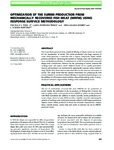Use este identificador para citar ou linkar para este item:
http://www.alice.cnptia.embrapa.br/alice/handle/doc/962441Registro completo de metadados
| Campo DC | Valor | Idioma |
|---|---|---|
| dc.contributor.author | FOGACA, F. H. dos S. | pt_BR |
| dc.contributor.author | TRINCA, L. A. | pt_BR |
| dc.contributor.author | BOMBO, A. J. | pt_BR |
| dc.contributor.author | SANT'ANA, L. S. | pt_BR |
| dc.date.accessioned | 2013-07-18T11:11:11Z | pt_BR |
| dc.date.available | 2013-07-18T11:11:11Z | pt_BR |
| dc.date.created | 2013-07-18 | pt_BR |
| dc.date.issued | 2013 | pt_BR |
| dc.identifier.citation | Journal of Food Quality, Malden, v. 36, n. 3, p. 209-216, June 2013. | pt_BR |
| dc.identifier.issn | 1745-4557 | pt_BR |
| dc.identifier.uri | http://www.alice.cnptia.embrapa.br/alice/handle/doc/962441 | pt_BR |
| dc.description | The by-products generated from industrial filleting of tilapia surimi can be used for the manufacture of surimi. The surimi production uses large amounts of water, which generates a wastewater rich in organic compounds (lipids, soluble proteins and blood). Optimizing the number of washing cycles will contribute to a more sustainable production. A mathematical model of mechanically recovered tilapia meat (Oreochromis niloticus) for the processing of surimi (minced fish washing cycles and tapioca starch addition) based on two quality parameters (texture and moisture) was constructed by applying the response surface methodology (RSM). Each factor had an important effect on the moisture and texture of surimi. This study found that the optimal formulation for producing the best surimi using the by-products of tilapia filleting in manufacturing fish burger were the addition of 10% tapioca starch and three minced fish washing cycles. A microstructural evaluation supported the findings of the mathematical model. | pt_BR |
| dc.language.iso | eng | eng |
| dc.rights | openAccess | eng |
| dc.subject | Design and Statistical Analysis | pt_BR |
| dc.subject | Moisture | pt_BR |
| dc.title | Optimization of the surimi production from mechanically recovered fish meat (mrfm) using response surface methodology. | pt_BR |
| dc.type | Artigo de periódico | pt_BR |
| dc.date.updated | 2013-07-18T11:11:11Z | pt_BR |
| dc.subject.thesagro | Tilápia | pt_BR |
| dc.subject.thesagro | Hamburger | pt_BR |
| dc.subject.thesagro | Tecnologia de alimento | pt_BR |
| dc.subject.nalthesaurus | Shear Stress | pt_BR |
| dc.subject.nalthesaurus | Scanning Electron Microscopy | pt_BR |
| riaa.ainfo.id | 962441 | pt_BR |
| riaa.ainfo.lastupdate | 2013-07-18 | pt_BR |
| dc.contributor.institution | FABIOLA HELENA DOS SANTOS FOGACA, CPAMN; LUZIA APARECIDA TRINCA, Instituto de Biociências de Botucatu, UNESP; ÁUREA JULIANA BOMBO, USP, Faculdade de Saúde Pública; LÉA SILVIA SANT’ANA, UNESP, Centro de Aqüicultura. | pt_BR |
| Aparece nas coleções: | Artigo em periódico indexado (CPAMN)  | |
Arquivos associados a este item:
| Arquivo | Descrição | Tamanho | Formato | |
|---|---|---|---|---|
| JournalFoodQualityFabiolaFogaca.pdf | 1,03 MB | Adobe PDF |  Visualizar/Abrir |









